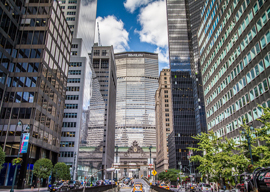
April 26, 2013

Park Avenue, New York
NEW YORK—The search for the two Chechen terrorists in Boston was nothing compared to mine for new digs in the Big Bagel. I accrued reams of knowledge while cruising the City that Never Sleeps with real-estate agents—did you know that New York has 5,200,000 trees? April is still cold and the branches are bare, but the pear and cherry trees are in full bloom and soon Manhattan will be under a green canopy.
On my way to judo at lunchtime and karate in the evening at Richard Amos’s dojo—he’s a Brit and has been teaching me now for 14 years—I witness the spring bird migration, with all sorts of species—they say more than 200—swooping into the Bagel on their way north. My favorites are the hawk on 74th Street atop 927 Fifth Avenue and the nesting peregrine falcons over the Brooklyn Bridge that sure no con man sells it to some unsuspecting Russki. And there’s always the friendly owl in the middle of Central Park—where I go to rest on Saturdays—who lives among the tall trees, tiny lake, and small streams of the 79th Street ramble.
The politicians made sure New York now resembles an African or Caribbean metropolis. This is no longer the city I once loved like no other, and that includes Paris, but it’s still an extraordinary sight, especially during the early hours coming home from a party in Brooklyn and seeing the skyline unfold with the dawn. Manhattan is still the place that screams, “This is where the money is,” while Brooklyn is now a middle-class borough full of baby carriages and men hurrying to work in suits on their bicycles.
What I miss most, especially during the return of drunken dawns, are the stickball games among poor kids, games I saw throughout my youth and even as late as the early 1970s in the side streets of Downtown Noo Yawk. Poor children used to play stickball in the streets, climb lampposts, and pitch pennies. No longer. Big Brother, as in Wall Street and Big Business, has become the Big Oppressor, its mega-towers banishing the sun and barricading the views, dumping the street urchins onto crowded subway platforms. Kids used to swim in fountains and in the East River. Today helicopters would be winching them up with traffic closed for safety’s sake.
And yet skyscraper hatred makes no sense. Manhattan without them would be an expensive Queens, and there are fewer than 20 buildings in the city that top 800 feet. We have the Great Depression to thank for the way the city’s shape dips low south of Midtown, and we have 9/11 to thank for the new glass pillars going up in the void left by the Twin Towers. The stratosphere is not as yet crowded, the brownstones are still uncrushed, and the undertow of nostalgia is still strong.